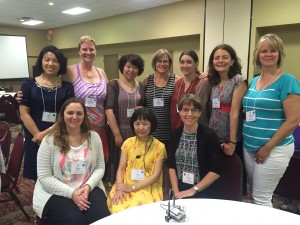
I wear various hats in my life but one that I’m particularly proud of is that of being a ‘mum’. As the parent of two young girls, I tell them that my most important job in life is to keep them safe. After that, it’s to nurture them, and foster a love of life in them so they can become resilient, engaged people. That’s a pretty tall order, and sometimes it’s easy to forget how big our job as parents can be, and how important our role is in shaping their futures. We are, after all, surrounded by professionals in our lives. And whether we have teachers, doctors, or other experts in our world, their knowledge can seem so much greater than ours.
As parents of children who are deaf or hard of hearing (d/hh), this is even more true. Indeed, if our child’s hearing loss was picked up during their youngest days, we can find ourselves supported by a team of early intervention professionals while we are still trying to find our feet as new parents. Although these experts can provide outstanding support, the information may be overwhelming and the learning curve can be steep. We might even be tempted to hand over a degree of responsibility in the decision-making for our children. However, research has shown that the most important relationship for a child in their language development is that of their mother (or other primary caregiver).
I was reminded of this recently when I was lucky enough to attend the annual Hands & Voices Leadership Conference, held in Texas for 2015. This was a great opportunity for me to reflect not just on my d/hh daughter’s development and needs, but also on my own journey as a parent to a d/hh child. With my ‘mum’ hat on, there were two presentations that really resonated with me. The first was about the social and emotional needs of d/hh children by Susan Rolinger and John Cool, and the second was on pragmatic language development for d/hh children by Christine Yoshinaga-Itano.
An important message for me was the importance of the quality of the communication we have between parent and child; the content of our communication is more important than the mode we use when fostering social and emotional wellbeing. For example, we need to make sure that we’re engaging in two-way conversations with our children, explaining social behaviours and situations to them, and naming and describing emotions. It doesn’t matter if we’re using our voices or our hands to do this.
Another interesting point was that pre-kindergarten d/hh children tend to spend less time with their peers than hearing children. When I think about it, this was certainly true for my daughter during her first two years, since a lot of our time then was spent with her early intervention team. This was indispensable to her blossoming into the beautiful four-year old that she is today. Now, that we’re reaping the benefits of that intense time, early intervention takes up less of our weekly schedule, and my daughter is able to enjoy more time with peers through preschool, music and gym classes, and getting together with her friends.
Building on these points was the fascinating issue raised around social language: even when our d/hh children have generally age-appropriate language skills, might they still struggle with mastering the rules for social language? Their vocabulary, grammar, speech articulation might be great but they might find it difficult to master the socially appropriate use and understanding of language, known as pragmatics. This gap can feed back to their wellbeing; problems with pragmatics can undermine their social confidence and acceptance.
What a lot of food-for-thought! The Hands & Voices conference reminded me that, just like this parent-driven organization, my husband and I are the ones who move our family forward. As part of a well-supported team, we are the ones who are best placed to make the right choices for our child.
Like 95% d/hh children, my daughter was born to hearing parents. My knowledge of parenting a d/hh child was low to start with but I built those skills with the support of our early intervention team. They helped me develop my communication, and my advocacy skills. They did this by not only teaching me but also setting such excellent examples. I’ve been lucky to work with amazing early interventionists. Right from the start, I was given compassion and guidance but above all else I was shown respect; respect that I could make the best choices for my daughter with their support. I was treated as a leader in my parenting choices.
Now that I’ve seen what great collaborations can come out of successful parent-professional relationships, I hope to carry this forward with me as my daughter transitions to kindergarten next year. When I walk into the first Individual Education Plan meeting, working with a new team of professionals, I’m going to hold my head high wearing my ‘mum’ hat. I’ll proudly say to myself ‘I’m the mum. I’m my child’s biggest advocate.’

